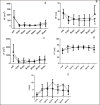Influence of Acute and Chronic High-Intensity Intermittent Aerobic Plus Strength Exercise on BDNF, Lipid and Autonomic Parameters
- PMID: 31191107
- PMCID: PMC6544002
Influence of Acute and Chronic High-Intensity Intermittent Aerobic Plus Strength Exercise on BDNF, Lipid and Autonomic Parameters
Abstract
The purpose of the present study is two-fold. First, we evaluated whether 8-weeks of combined training (high-intensity intermittent plus strength training) may change brain derived neurotropic factor (BDNF) and lipid parameters (triacylglycerol, HDL-c and non-HDL) in a fasted state. Second, we investigated the effect of an acute session of high-intensity intermittent exercise followed by strength training on systemic BDNF and lipid parameters pre- and post 8-weeks of training. Twenty-one healthy and physically active men were divided into two groups: high-intensity intermittent exercise combined with strength training (HSG; n = 11) and control (CG; n = 10). The HSG exercised for one minute at 100% of speedVO2max (sVO2max) interspersed with one minute of passive recovery followed by strength training (8 exercises with 8-12 repetition maximum loads) for 8-weeks. Heart rate variability, blood pressure, lipid profile, and BDNF concentrations were measured in the fasted state pre- and post-exercise and before and after the 8-week training period. After 8-weeks of exercise training, there was an increase in spectral high frequency component (ms2) and RR interval (p < 0.05), a decreased spectral low frequency component (nu) and heart rate values (p < 0.05), an increase in HDL-c (p < 0.001), and lower BDNF concentrations (p < 0.001). These results suggest that 8-weeks of high-intensity intermittent exercise combined with strength exercise is an effective protective cardio-metabolic strategy capable of increasing HDL-c and BDNF concentrations after an acute exercise session. In the long-term, the modulation on BDNF and HDL-c concentrations may be a determining factor for protection against neurological and cardiovascular diseases.
Keywords: HIIT; autonomic modulation; cholesterol; combined exercise; health; heart rate variability.
Figures




References
-
- Babaei P., Damirchi A., Mehdipoor M., Tehrani B. S. (2014) Long term habitual exercise is associated with lower resting level of serum BDNF. Neuroscience Letters 566, 304-308. - PubMed
-
- Bhati P., Moiz J. A., Menon G. R., Hussain M. E. (2018) Does resistance training modulate cardiac autonomic control? A systematic review and meta-analysis. Clinical Autonomic Research, 1-29. - PubMed
-
- Besnier F., Labrunée M., Pathak A., Pavy-Le Traon A., Galès C., Sénard J. M., Guiraud T. (2017) Exercise training-induced modification in autonomic nervous system: An update for cardiac patients. Annals of Physical and Rehabilitation Medicine 60(1), 27-35. - PubMed
-
- Brown L. E., Weir J. P. (2001) ASEP procedures recommendation I: accurate assessment of muscular strength and power. Journal of Exercise Physiology Online 4(3).
Publication types
MeSH terms
Substances
LinkOut - more resources
Full Text Sources
Research Materials
